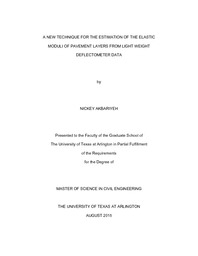
ATTENTION: The works hosted here are being migrated to a new repository that will consolidate resources, improve discoverability, and better show UTA's research impact on the global community. We will update authors as the migration progresses. Please see MavMatrix for more information.
Show simple item record
| dc.contributor.author | Akbariyeh, Nickey | en_US |
| dc.date.accessioned | 2015-12-11T23:20:12Z | |
| dc.date.available | 2015-12-11T23:20:12Z | |
| dc.date.submitted | January 2015 | en_US |
| dc.identifier.other | DISS-13342 | en_US |
| dc.identifier.uri | http://hdl.handle.net/10106/25401 | |
| dc.description.abstract | This study developed a method to estimate the elastic moduli of a flexible pavement system from Light Weight Deflectometer deflection data. The forward method (simple equations) can be easily programmed into the data acquisition device of the Light Weight Deflectometers. The equations can be of a primary assistance in the evaluation of the flexible pavement structures. The method is simple and it eliminates the need for the backcalculation procedure after the LWD test. The pavement systems considered in this study are composed of 2 to 4 inches of the asphalt concrete wearing layer and 4 to 8 inches of compacted granular base layer, structures commonly used for low and medium volume roads. By utilizing the layered-elastic computer model WinJULEA, surface deflections have been computed assuming various combinations of layers thickness and layers moduli. Two different deflection datasets have been generated. The first deflection dataset was generated for three geophones offset distances: 0, 9 in and 18 inch from the center of an 8 inch diameter loading plate. The second deflection dataset was generated for the 12 inch diameter loading plate and three geophones at the offset distances of 0, 12 and 24 inches from the center of the loading plate. The subgrade moduli have been considered as a constant value (10 Ksi).After generating the data bases, deflections have been reported in terms of two relative ratios, d1 and d2. The d1 ratio is the ratio between the deflections measured by the central geophone to the deflection measured by the outer geophone. The d2 ratio is the ratio between the deflections measured by the middle geophone and the outer geophone. The SAS statistical analysis software was used to conduct a multi-linear regression analysis. Two sets of equations have been found best relate the elastic moduli of the upper pavement layers to the surface deflections: a pair for pavements with asphalt surface layer thickness between 2.0 and 3.0 inches and another pair for the asphalt layer thickness between 3 and 4 inches. The equations can be easily used to compute the elastic moduli of a three-layer pavement structure from the deflections measured by the LWD. | en_US |
| dc.description.sponsorship | Romanoschi, Stefan | en_US |
| dc.language.iso | en | en_US |
| dc.publisher | Civil & Environmental Engineering | en_US |
| dc.title | A New Technique For The Estimation Of The Elastic Moduli Of Pavement Layers From Light Weight Deflectometer Data | en_US |
| dc.type | M.S. | en_US |
| dc.contributor.committeeChair | Romanoschi, Stefan | en_US |
| dc.degree.department | Civil & Environmental Engineering | en_US |
| dc.degree.discipline | Civil & Environmental Engineering | en_US |
| dc.degree.grantor | University of Texas at Arlington | en_US |
| dc.degree.level | masters | en_US |
| dc.degree.name | M.S. | en_US |
Files in this item
- Name:
- Akbariyeh_uta_2502M_13342.pdf
- Size:
- 680.3Kb
- Format:
- PDF
This item appears in the following Collection(s)
Show simple item record


